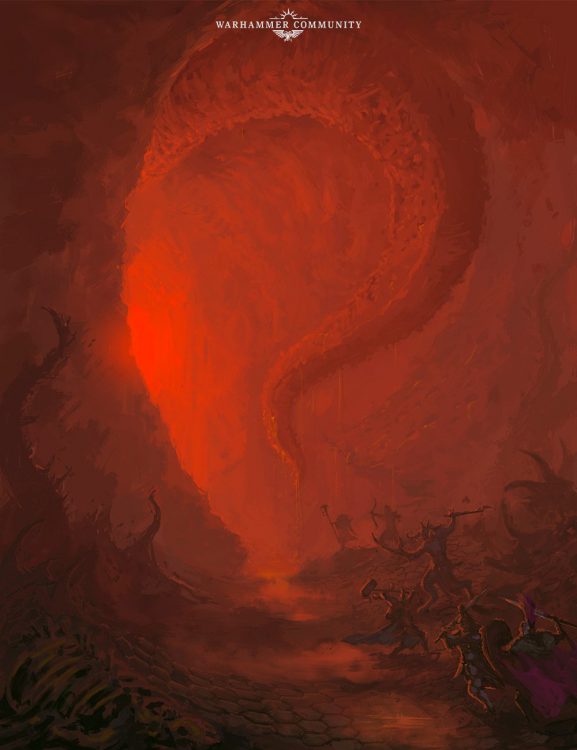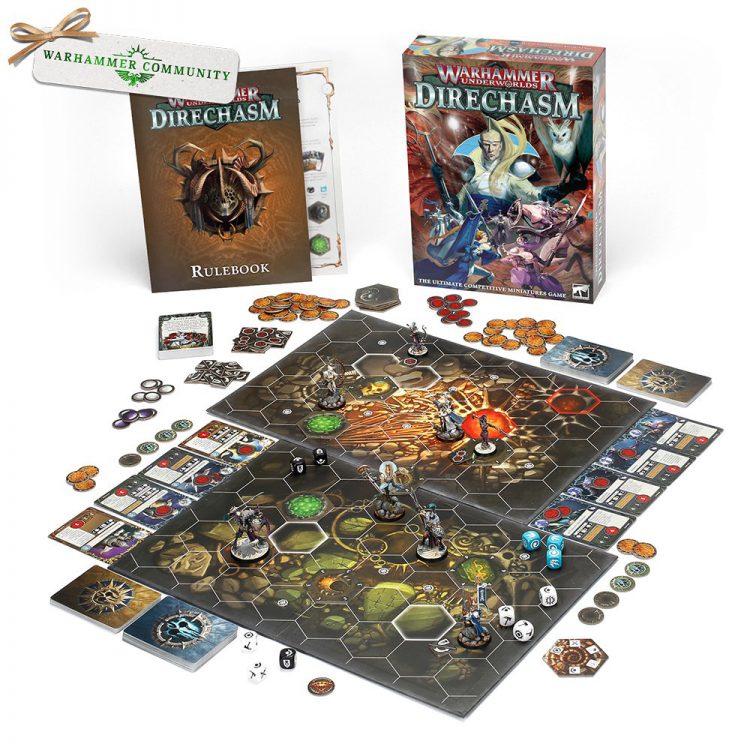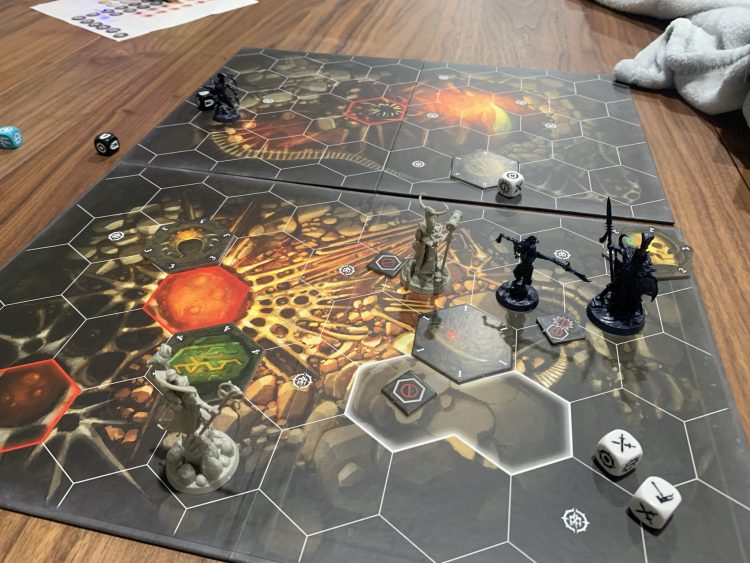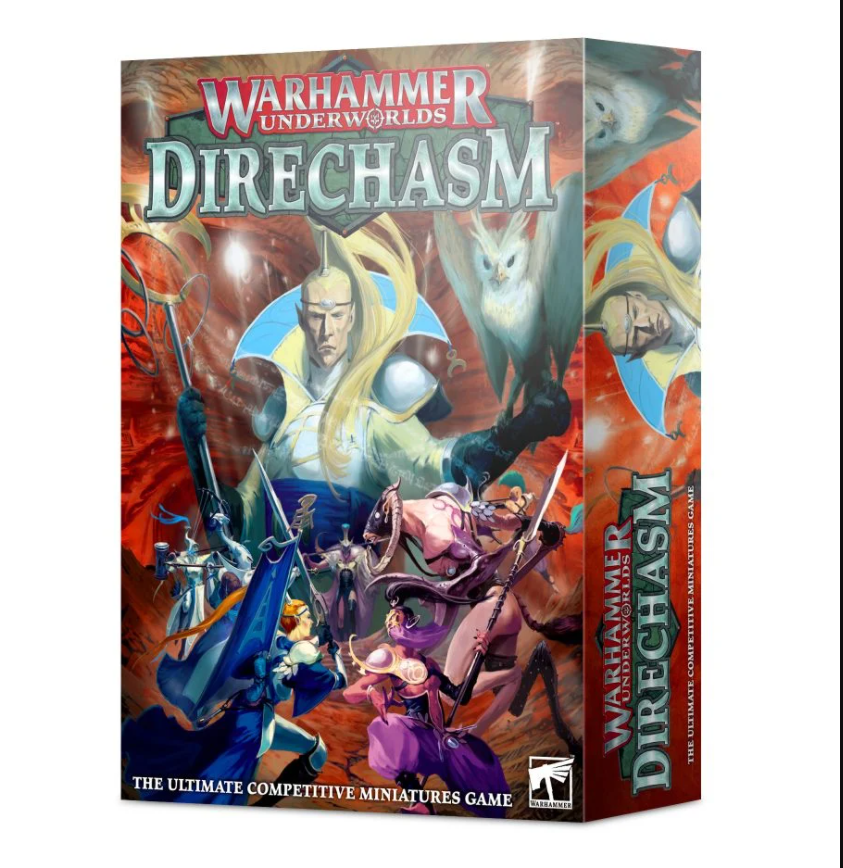Another year has gone by and so arrives a new season of Warhammer Underworlds. While the release has been delayed a touch by, you know everything, Direchasm comes hot on the heels of the latest expansions. Like previous core sets Direchasm brings two new warbands and a handful of Universal cards; however the design team has made quite a number of impactful changes to this season. Last year I said that Beastgrave was the most new-player friendly core set so far. Has Direchasm grabbed that glory?

Narrative
Looming over the horizons of Ghur—some say every horizon no matter where you look—is the mountain known as Beastgrave. Like everything in the realm of beasts, Beastgrave is a feral roaming predator. Ever so slowly the mountain walks, consuming everything it comes across. While is sort of a base level phenomenon for the mountain, something else has begun. The mountain is awakening.
Deep in the heart of Ghur something is pulsing. As this energy grows stronger, so do the creatures of Ghur grow more feral. This is also true of the Great Mountain. Deep in its core it is stirring. In its depth, something is rising. The deepest cavern of Beastgrave is known as the Direchasm. Until now its passages had been sealed by hardened amber, but this amber has liquefied and freed its treasures—and monsters.
As Underworlds matures, so does the lore associated with it. Artifacts recovered from Shadespire assisted Morathi as she freed Slaanesh in the latest Broken Realms, and Direchasm hints at an ever-expanding plot of Nagash to use the Curse of the Katophranes to corrupt every realm from the inside. This curse has contributed to Beastgrave awakening too early in the cyclical pulse of Ghur. The amber filled passages of the Direchasm has melted away too early, revealing the insect-like keepers of the Chasm in a larval form. The lore says they’ve slinked away in hiding but I wouldn’t be surprised to see them show up in the cards this season. Related, perhaps, to the Ur-Grub?

As Beastgrave feeds on primal energy and grows hungry, so do the fighters inside. This hunger is represented mechanically—more on that soon—but narratively its described as the warbands stuck in Beastgrave’s depths fighting with greater abandon and recklessness. No one is immune, though some seem to enjoy it. The Dread Pageant is a warband of Slaaneshi cultists who have made their way into Direchasm, hoping to use the cracks caused by the Necroquake to enter the realm of Slaanesh. However, the pain and fury of the mountain is rather alluring to the Pageant. Feeding off its energy, they inflict pain and death slowly to tease and anger the mountain slowly.
Myari’s Purifiers on the other hand, have been dispatched to do the opposite. Fearing that the awakening of Beastgrave could spell cataclysmic doom they hope to find a way to calm the mountain and bring an end to the destruction. They carry with them the light of Hyish, and aetherquartz stone that empowers them. No one is immune to the feral energies of the mountain however. Will they hold on to their mission as they descend deeper and deeper into Direchasm? We’ll find out in a Black Library book maybe one day.
Inside the Box

A new season means a new core set, and the Direchasm core box is going to look mighty familiar to Underworlds veterans. As always, we’ve got two push-fit warbands, two game boards, a pile of tokens and dice, and some pre-built decks ready for playing. Following the decision made in the Beastgrave season, each of our two warbands—the Slaaneshi Dread Pageant and Miyari’s Lumineth Purifiers—comes with enough faction specific cards to build Glory and Power decks made exclusively of Faction Cards. I loved that decision last year and I still love it now.
In a major departure from previous seasons, the stack of Universal cards provided for deck building is an entirely new set of unique cards. No more Hold Objective 1-5, no more Sidestep or Great Strength. As an experienced player this is really nice; I get more variety out of the core set and still get access to those classics in Championship Format events via Beastgrave. However it’s especially exciting for the new Vanguard format. In Vanguard events, only cards from the current season are legal; this will push early deckbuilding away from the old standards.
The warbands are the same high quality we’ve come to expect, and go together pretty easily. While neither warband is my jam aesthetically, I can still appreciate the design of the models. Shoutout to Miyari’s Scryowl and Slakeslash’s Crabby Left Arm as my favorite elements of this box. A note, Miyari’s staff is especially fragile. I know at least one person whose staff arrived broken on sprue and the top of mine popped off while cutting it off the sprue and it bounced into the shadow realm. Be careful taking the Lumineth off the sprue.
Rules Updates
As far as the rulebook goes, there are some notable changes and a Day 1 errata worth pointing out. The first change is that taking out fighters with a Wound Characteristic of 6+ awards 2 glory instead of 1. Take that Hrothgor. Worth noting that cards like Great Fortitude increase the Wounds Characteristic and thus its possible to boost a fighter into this bonus glory zone. Weirdly, there is no way to get any of the fighters in the Core Set to 6+ wounds so if you’re coming in new it’s worth noting this as a rule you won’t get any experience with for now.
The much bigger change is the change to support. A fighter receives support when a friendly fighter is adjacent to the target of their attack, or when a friendly fighter is adjacent to an enemy fighter targeting them. In previous editions, support offset in such a way that to count as having support you needed to have more support than your opponent. Now it doesn’t matter how much support your opponent has; you still get support from your friendly fighters and count the Support symbols as success on your dice. This simplifies the support rules, but more importantly it makes Underworlds a much deadlier game. Support will be more common in any game you play and as this change favors which ever player is rolling more dice, it will usually favor the attacker. There is a knock-on effect of making Power and Glory cards related to support more powerful.
Finally, the rulebook states that boards set up long-edge to long-edge must be connected by 3 full hexes. This is how its always been, however a recent FAQ update has changed this rule to requiring 4 full hexes. This is a subtle change that benefits aggressive warbands. Together with the changes to Support, it’s clear that the design team noticed the dominance of Objective Holding warbands last season and has adjusted.
The Warbands
After getting a number of games in with these two bands fighting each other, I’m happy to report that I’ve settled into an even sort of balance between them. Initially, the Dread Pageant rolled over the lithe aelves repeatedly. Their cards reward aggression and if they win the roll and can set up with wide, even boards it’s hard to keep them away. They’re fast. The Purifiers took some time to get acclimated by my table, but now that I’ve learned to play patiently they’ve won a few games themselves. As a reminder, all my games have been using only the pre-built faction decks. We’ll take a look at the universals in the box later.

The Dread Pageant is made up of 4 fighters. All sport a Movement of 4 that bumps to 5 when inspired, though that’s the only immediately immediately remarkable thing about the warband. Vasillac the Gifted is your leader. He has a reasonably accurate attack that does just 2 damage uninspired, though it picks up to 3 damage with Cleave once inspired. More importantly, its got a 2 hex range which is always handy. Slakeslash is the eye-catching Slaangor with the Crab Claw who is a reasonable lieutenant who sports a whopping 5 wounds. Now normally a warband has a few weaker models but what I love about this warband is that they’re surprisingly useful. Your archer Hadzu has quite the threat range and his ability is a great one; instead of drivnig back an enemy after shooting them Hadzu can push them. This gives you quite a bit of flexibility in moving your opponent around. Finally, Glisette is my all-star. While she’s only got 2 wounds, always being on Guard makes her very survivable and the 2 range attack makes it easy to line up support.
I said that they aren’t immediately remarkable, however this warband has quickly become one of my favorite ones to mess around with. The various abilities the squad has are sneakily powerful (Glisette, maybe not so sneaky). Vasillac and Slakelash can both damage or heal themselves after attacking, giving you the flexibility to meet your inspire condition and then heal up afterwards. Glisette dances on the edge of a blade as a single bad defense roll can take her out, but she’s been my combat MVP. With Hadzu pushing and pulling people around the board, I’ve found the Dread Pageant to be tactically rewarding. Slakeslash doesn’t put out a ton of damage on his own but your opponent isn’t going to want to leave him in their backline throwing wound tokens everywhere and inspiring you. While these decks don’t interact with it, Slakeslash is both a Hunter and a Quarry so I’m excited to play around with those Keywords.

The Purifiers are quite a different play experience. They’re much easier to inspire (though less powerful when inspired) and each sport an Aetherquartz counter to start. These can be spent for as single re-roll, or to interact with various faction ploys and objective cards. While you likely want to save them for the more powerful effect on those Ploys, I often found myself using them to save an incoming kill shot or to fish for an inspiration. I found success with these when I held back and let the Pageant come to me. Their cards favor a flex style where you hold objectives and attack when needed, so being patient and considered plays to their strengths.
As for the fighters, Mayari is your leader and wizard with a nice 3-range ping spell that I found myself not using much because I didn’t want to inspire the Pageant. Bahannar is a stout lieutenant; great survivability with 2 Defense dice looking for shield, and once inspired his 3-damage attack can crush your opponents. He’s an interesting fighter as he can’t be pushed back if he hasn’t moved, meaning once he’s stuck in he’s hard to move. The Purifiers also have an archer though Sanaela plays quite differently than her counterpart. Once inspired, Sanaela has an attack with a stunning 5 hex range and an alternate short-range shot that deals extra damage on a crit. Finally, there’s Ailenn who is simply solid. Inspired her 2-damage attack is dependably accurate and even sports cleave.
Overall Thoughts

Honestly, I was a little less excited going into this season than previous ones. Aesthetically, neither warband speaks to me and because Core Sets used to have so many generic cards it was difficult to get a feel for how the season was going to go. Direchasm has ultimately exceeded my expectations. Both warbands have a tactical richness that revealed greater depth with each game, and the rules changes have made a significant impact. Check back soon for a card-by-card review, but the new Universals are exciting and its nice to have a full set of new cards. It looks like Direchasm has introduced a Hunger token system where your fighters can get stronger by earning Hunger tokens. Additionally, cards that refer to a new Primacy Token give you the opportunity to score additional mid-game glory.
I do think that ultimately Direchasm has taken a step back from Beastgrave as a new player product. Some of the cards in this box have a full paragraph of text with very specific and complex wording. They parse clearly, but they’re intimidating. Also, the warbands themselves aren’t as immediately dynamic as I thought the two in Beastgrave were. However, this is only relevant as a comparison. It’s still a great core set and the introduction of the Vanguard format makes this a fantastic time to get into the game. Additionally, the new set of Universals means its still easy to recommend Beastgrave as a second purchase or concurrent purchase. No card overlap means you get a nice pool of Universals to bring to a Championship format game.
Year after year Warhammer Underworlds is my most played game, board game or miniatures game. I don’t see that changing in 2021. We’re off to a killer start.


